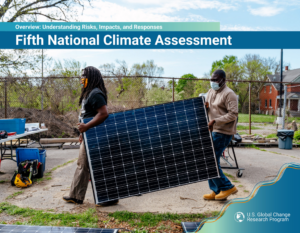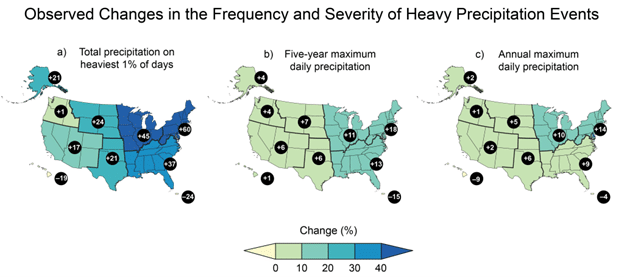Drastic cuts to planet-warming emissions and preparations for some unavoidable change will benefit people now, not just future generations.

The Fifth National Climate Assessment, released November 14th, makes the several key points crystal clear:
- We are in the throes of climate change. Climate change is not a future, abstract expectation. It is a painful reality that is playing out in every region of the country.
- The more the planet warms, the more severe, costly, and harmful the effects will be. With each increment of warming, the risk of catastrophic, unforeseen consequences grows.
- The converse is also true. Each increment of warming avoided by proactive action to reduce planet-warming emissions from the burning of fossil fuels reduces these risks. The degree of harm and expense we will face is in our hands.
- Rapid emissions reductions will not just benefit future generations, but will benefit people and ecosystems now. Emissions cuts will have immediate health and economic benefits. The economic benefits of making drastic cuts to systems that use fossil fuels easily outweigh the long-term costs of damage caused by continuing to use those systems.
The National Climate Assessment is a detailed, rigorous examination of the status of climate science across 13 federal agencies, drawing information from major academic, public, and private institutions in every state. It is the gold standard for understanding where climate change is taking us in the United States.
Prior Assessments Confirmed
To those that follow climate change news and science, much of the report will sound like the old versions. Climate change is real, human-caused, and accelerating in its pace of effects. The speed of the warming we’re living through is unprecedented in recorded human history. To avoid the worst impacts, we need to reduce emissions from transportation by prioritizing public transit, electric vehicles, and we need to build communities that are bikeable and walkable. We need to eliminate our use of fossil fuels as much as possible as fast as possible. We need to protect as much land as possible and safeguard natural resources. We also need to face the reality that we will have to adapt to some degree of climate change into the foreseeable future. We’ve heard all of this before, but now, unfortunately, we have the receipts. What was once forecast has come to pass.
Climate Impacts in the Midwest
In the Midwest, the key impacts are much like we’ve read in previous iterations of the assessment as well. Total precipitation is increasing. The strongest storms are getting more frequent and more powerful. The heaviest 1% of storms are now delivering 45% more precipitation when compared to the middle of the 20th century. With a greater portion of our annual precipitation coming in heavier events, there is more potential for unpredictable, variable, damaging weather. This is a primary concern for HRWC.

Threat Multiplier for Aging Infrastructure
The Midwest Chapter also calls out the vulnerability of aging infrastructure, including dams specifically. Just this past August, parts of the Huron River watershed experienced what could be classified as a “1000-year storm” after suffering a “500-year storm” the night before. In the rush of water, part of the Tyler Dam on a tributary to the Huron River in Belleville washed out. These are the sort of events that keep me up at night. Without aggressive action to reduce emissions and without significant funding to address obsolete infrastructure, these effects could become more common and deadly.
If there is hope to be found, it’s that what lies ahead is completely within the realm of humans to determine. Which path we follow depends on how much we’re willing to do.
Kate Marvel, a climate scientist and a chapter lead author, said, “All of our future projections are conditional on the emissions scenario: if we don’t want the world to warm by 3°C or 4°C, we know what to do.”
Learn about some ways HRWC is working to reduce the threats of climate change to the Huron River in our 2022-2023 Annual Report to the Community.



